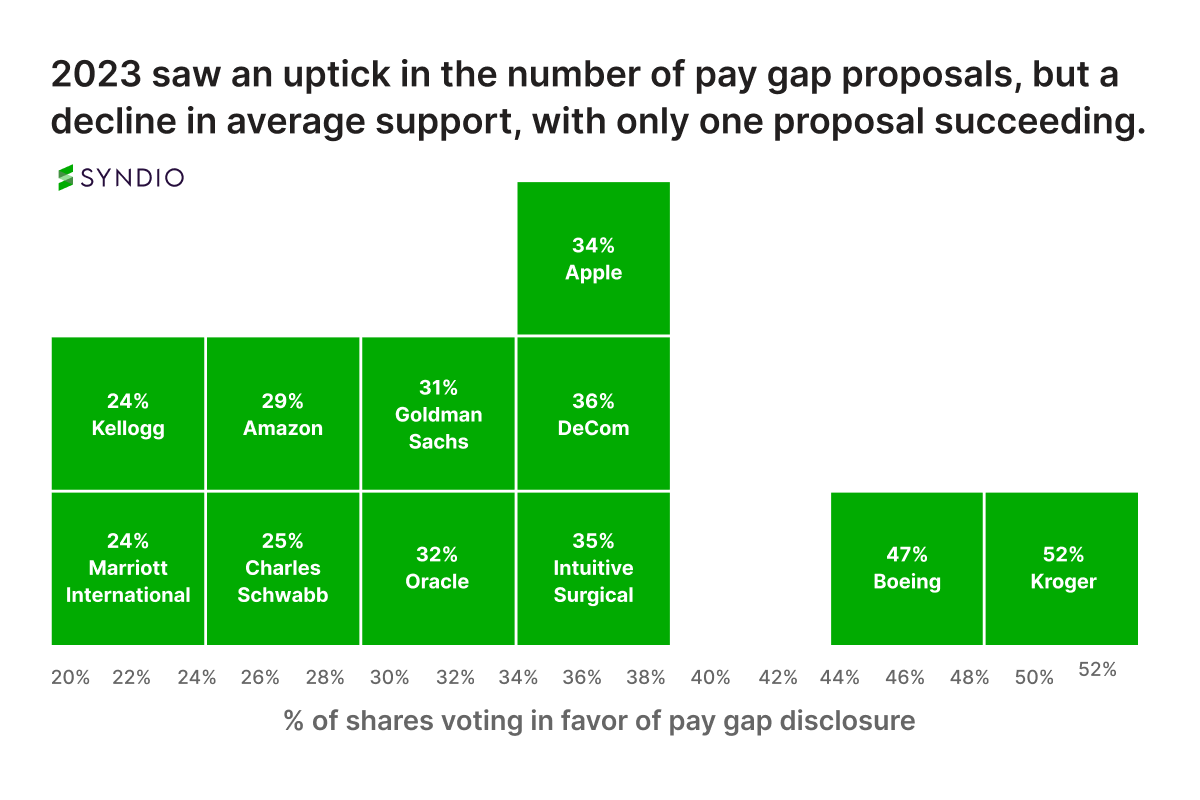There is surround-sound pressure on large organizations to track, disclose, and reduce gender and racial pay gaps, from new and beefed-up laws to an increased willingness of employees to share their compensation publicly. Activist shareholders led by Arjuna Capital have also pressured publicly traded companies through shareholder proposals to disclose median pay gaps.
Overall, we tracked 11 pay gap reporting proposals in the 2023 proxy season, up from the seven we tracked in 2022. Ten of these proposals failed, with one passing narrowly (Kroger at 52%) and one just barely failing (Boeing at 47%). Two proposals were repeats from the 2022 proxy season, when they failed to pass with essentially the same amount of support in 2023: 29% at Amazon and 34% at Apple. The final pay gap proposal we tracked in the 2023 season took place on November 15, when Oracle’s shareholders sided with management against median pay gap disclosures.
According to this analysis by attorneys from Orrick, the support for these proposals is lower in 2023 than it was in previous seasons, but the votes here are still high enough to warrant engagement with the groups making the proposals. Additionally, several organizations have negotiated out of proposals by agreeing to disclosures voluntarily — including Blackrock this year and Microsoft last year.
Companies are becoming less leery of these disclosures because they are more common (Arjuna reports that over 40 companies in the U.S. are currently disclosing), and there is a growing wave of legislation in the EU and U.S. that require organizations to track and potentially disclose this statistic. A similar law has been on the books in the UK since 2017, and many global corporations have grown accustomed to their median pay gaps being public knowledge in the UK for years. (We launched a UK pay gap benchmarking tool where you can compare your organization’s gender pay gap to over 10,000 unique companies’ UK disclosures.)
Read more > Is unadjusted pay gap reporting coming to the U.S.? >
How can organizations get ahead of pay gap proposals?
Companies either choose to disclose their median pay gaps, or continue to resist disclosure. In either case, companies can prepare by dialing in their workplace equity programs. Our 2024 Workplace Equity Trends Report provides guidance on how leading organizations approach workplace equity, but we can learn specifically from organizations who already disclose their unadjusted pay gaps and those who have convinced shareholders to side with them against activist proposals in the 2023 proxy season.
UK-based organizations have led the way on proactive communication that accompanies their unadjusted pay gap reports. Best practices here include education about:
- What the unadjusted pay gap means
- A commitment to equal pay for equal work and the work done to support that commitment
- A discussion of other drivers of the unadjusted pay gap (such as declining representation of women and people of color in management, leadership, or high-paying professional roles)
- The organization’s goals and plans to close the opportunity gap at their organization
Ironically, the path of resisting disclosure overlaps significantly with preparing a disclosure. The report from the Orrick attorneys noted that the organizations who lost pay equity shareholder votes either did not have a public commitment to pay equity or did not disclose that they conducted (or planned to conduct) pay equity analyses. With pay equity, proactive analysis and communication are prophylactic. The Orrick attorneys noted the following factors that correlate with more favorable votes for management:
- Diversity goals at the management level
- Reporting adjusted pay gap data (calculated by grouping similarly situated employees and controlling for neutral, job-related factors)
- Conducting pay equity analyses
- Making a public commitment to pay equity
- Disclosing EEO-1 reports
These criteria are the public face of a well-functioning workplace equity program — the sort of programs that will reduce their median pay gaps over time.
Get your house in order now through proactive analysis
Syndio’s Workplace Equity Analytics Platform provides comprehensive analytical support for workplace equity programs, tracking and benchmarking your demographics in specific roles and management, while identifying differences in pay, promotions, performance, and more that lead to pay and opportunity gaps.
Learn more about how leading companies are approaching workplace equity in 2024 with the latest Workplace Equity Trends Report.
The information provided herein does not, and is not intended to, constitute legal advice. All information, content, and materials are provided for general informational purposes only. The links to third-party or government websites are offered for the convenience of the reader; Syndio is not responsible for the contents on linked pages.



